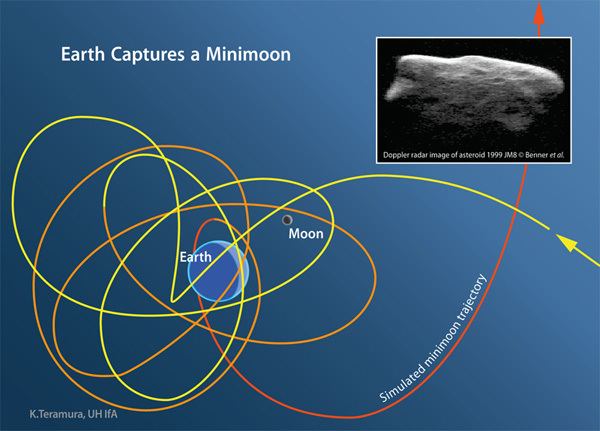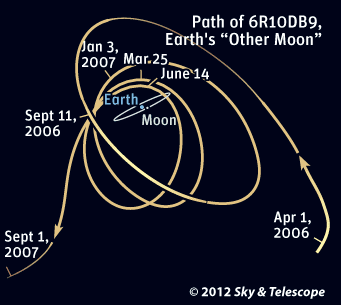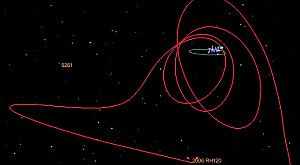Discovery date 14 September 2006 Observation arc 281 days Rotation period 2.8 minutes | MPC designation 2006 RH120 Discovered 14 September 2006 Absolute magnitude 29.5 | |
 | ||
Aphelion 1.058 AU (158.3 Gm) (Q) Similar Solar System, 3753 Cruithne, 2002 AA29, (469219) 2016 HO3, (419624) 2010 SO16 | ||
2006 RH120 is a tiny near-Earth asteroid with a diameter of about 2–3 meters that ordinarily orbits the Sun but makes close approaches to the Earth–Moon system around every twenty years, when it can temporarily enter Earth orbit through temporary satellite capture (TSC). Most recently, it was in Earth orbit from September 2006 to June 2007.
Contents

Until given a minor planet designation on 18 February 2008, the object was known as 6R10DB9, an internal identification number assigned by the Catalina Sky Survey.

Discovery

2006 RH120 was discovered on 14 September 2006 by the 27-inch (690 mm) Schmidt camera of the Catalina Sky Survey in Arizona. "6R10DB9" was the Catalina Sky Survey's own discovery designation for this object, which usually would only be used on the MPC's NEO Confirmation Page (NEOCP) until an IAU designation was applied, if the object was classified as a minor object. It was added on 14 September to the NEOCP and subsequently removed with the explanation that it "was not a minor planet". Preliminary orbital calculations indicated it was captured by Earth's gravity from solar orbit of a period of about 11 months, which is similar to that of many spent rocket boosters dating to the Apollo program of the 1960s and early 1970s. 6R10DB was assigned the designation 2006 RH120 on 18 February 2008.
Origin

Some controversy existed regarding the origin of the object. Upon discovery, it was not given a formal name because its size, orbit, and spectrum were consistent with the white titanium-oxide paint used on Saturn V rockets, which meant it could be an artificial object. Precedents for this exist: J002E3 is currently thought to be the third-stage Saturn S-IVB booster from Apollo 12 and was in an almost identical orbit, and 6Q0B44E, discovered a month earlier, was also thought to be artificial. Its status as a satellite was also debated, with A. W. Harris of the Space Science Institute commenting, "Claiming some bit of fluff in a temporary looping orbit to be a ‘satellite,’ with all the baggage that term carries, is mere hype".
Orbit

Analysis has shown that solar-radiation pressure is perturbing its motion perceptibly. However, Paul Chodas in JPL's Solar System Dynamics Group suspects that the perturbations are consistent with expectations for a rocky object but not with old flight hardware. One hypothesis is that the object is a piece of lunar rock ejected by an impact. On 18 February 2008, the object was given a minor planet designation.

The object made four Earth orbits of about three months each before being ejected after the June 2007 perigee. At that perigee, it dipped inside the Moon's orbit to a distance of 276,845 kilometres (172,024 mi). 2006 RH120 became an Apollo-class asteroid in June 2007.
14 June 2007 perigee
On 14 June 2007, 2006 RH120 made its fourth and last perigee of the most recent Earth encounter. It was 0.7 lunar distances at closest, with an apparent magnitude of 18.5–19.0.
Astronomers at JPL Goldstone in California, USA made radar astrometry measurements on 12, 14 and 17 June 2007.
Future events
2006 RH120 is now in solar orbit as an Amor-class asteroid with an orbit completely outside of Earth's orbit. As of 2017, this object is 2 AU from Earth on the other side of the Sun. Systematic residuals in the positions of the object probably indicate that the model used to determine solar radiation pressure may be too simple to adequately describe its motion over a long period of time. The next near-Earth encounter is in August 2028 when the object will pass Earth at a relatively low speed of 136 metres per second (304 miles per hour). For comparison, on 13 April 2029, asteroid 99942 Apophis will pass Earth at a relative speed of 7.4 kilometres per second (17,000 miles per hour). 2006 RH120 is listed as part of the Near-Earth Object Human Space Flight Accessible Targets Study (NHATS).
